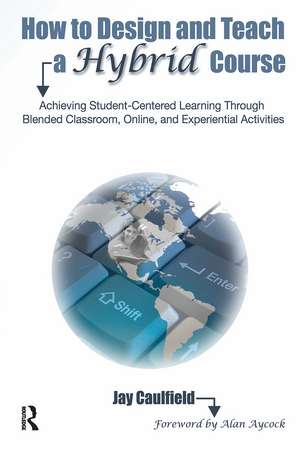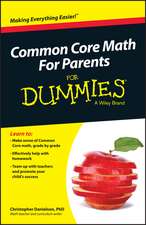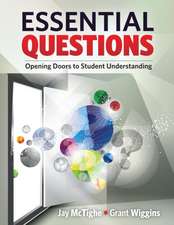How to Design and Teach a Hybrid Course: Achieving Student-Centered Learning through Blended Classroom, Online and Experiential Activities
Autor Jay Caulfielden Limba Engleză Paperback – 25 iul 2011
| Toate formatele și edițiile | Preț | Express |
|---|---|---|
| Paperback (1) | 276.29 lei 43-57 zile | |
| Taylor & Francis – 25 iul 2011 | 276.29 lei 43-57 zile | |
| Hardback (1) | 984.78 lei 43-57 zile | |
| Taylor & Francis – 25 iul 2011 | 984.78 lei 43-57 zile |
Preț: 276.29 lei
Nou
Puncte Express: 414
Preț estimativ în valută:
52.89€ • 54.40$ • 43.88£
52.89€ • 54.40$ • 43.88£
Carte tipărită la comandă
Livrare economică 17 februarie-03 martie
Preluare comenzi: 021 569.72.76
Specificații
ISBN-13: 9781579224233
ISBN-10: 1579224237
Pagini: 266
Dimensiuni: 152 x 229 x 18 mm
Greutate: 0.37 kg
Ediția:1
Editura: Taylor & Francis
Colecția Routledge
Locul publicării:Oxford, United Kingdom
ISBN-10: 1579224237
Pagini: 266
Dimensiuni: 152 x 229 x 18 mm
Greutate: 0.37 kg
Ediția:1
Editura: Taylor & Francis
Colecția Routledge
Locul publicării:Oxford, United Kingdom
Public țintă
Postgraduate and Professional Practice & DevelopmentCuprins
Acknowledgments Foreword By Alan Aycock Preface SECTION ONE. INTRODUCTION 1 WHAT IS HYBRID? 2 THEORETICAL APPLICATIONS 3 EXPERIENTIAL LEARNING 4 PLANNING YOUR HYBRID COURSE. Critical Questions to Consider SECTION TWO. DESIGNING AND TEACHING YOUR HYBRID COURSE 5 DISCUSSION AS A WAY OF LEARNING IN A HYBRID COURSE 6 PROVIDING AND SOLICITING STUDENT FEEDBACK 7 USING SMALL GROUPS AS A LEARNING STRATEGY 8 MEETING STUDENT EXPECTATIONS 9 ENHANCING TEACHING THROUGH THE USE OF TECHNOLOGY SECTION THREE. INTERVIEW DATA 10 WHAT STUDENTS SAY ABOUT HYBRID 11 WHAT THE BEST HYBRID TEACHERS SAY 12 WHAT THE BEST HYBRID TEACHERS DO CONCLUSION 13 COMING FULL CIRCLE, FUTURE RESEARCH, AND FINAL REFLECTIONS References Index Reference Index
Notă biografică
Jay Caulfield is an associate professor and an associate dean at Marquette University, where she has led the curriculum design of the college’s hybrid graduate degree in leadership studies. She routinely teaches courses in leadership theory, organizational behavior, and research methods, and has moreover taught over 80 hybrid courses within the past eleven years. She serves on numerous university and college committees and boards including the University Board of Graduate Studies, the Institutional Review Board, and the Committee on Teaching, which she recently chaired. She is currently a member of the International Leadership Association and the International Society for the Scholarship of Teaching and Learning. In spring of 2011 she received the college’s Faculty Excellence in Service Award for her significant long-term contributions to the College, as evidenced by her teaching, leadership and service to students, fellow faculty, staff and the greater community. Caulfield’s research interests include transformational leadership and adult learning. Recent peer reviewed publications include, Why should I tell you how you teach? An expectancy theory perspective and Applying graduate student perceptions of task engagement to enhance learning conditions. She and colleagues are currently engaged in a longitudinal study on transformational leadership and she is authoring a second book on transformational coaching.
Recenzii
“I’ve kept abreast as best I can on the burgeoning literature on hybrid (or blended, in the UW-Milwaukee lexicon) teaching, so I feel comfortable in saying that the book you now hold in your hands is well worth your time: it’s a book that I believe to be basic to any instructor’s appreciation of the full value of blended teaching and learning.”
Alan Aycock, Professor of Anthropology and Acting Director
University of Wisconsin-Milwaukee’s Learning Technology Center
“Dr. Caulfield’s book on how to design and teach a hybrid course offers necessary and valuable information to faculty and students alike. Moreover, her convergence of theory, experience, and application will definitely advance the current work in the field of designing and teaching hybrid courses.”
Robert Deahl, Dean, College of Professional Studies, Marquette University, and Past President
Commission on Accelerated Programs
“This book will be a valuable resource for faculty in higher education who are planning, designing, teaching, and evaluating a hybrid course. Jay Caulfield combines interview data from experienced hybrid teachers with an extensive literature review to provide practical tips and guidelines for creating a successful hybrid teaching and learning experience.”
Norm Vaughan,co-author, Blended Learning in Higher Education, and
Mount Royal University, Canada
“Teaching a hybrid course well demands careful planning. This book provides excellent guidance on how to do that planning.”
Dee Fink, National Project Director: Teaching & Curriculum Improvement (TCI) Project, and Senior Associate
Dee Fink & Associates Consulting Services
“Dr. Caulfield has a great deal of experience with hybrid teaching methods and she has studied and worked with some of the leading figures in the hybrid movement. She effectively uses her experience and the experience of others who have both scholarly and practical knowledge of hybrid teaching methods to present a very readable and helpful account of the factors that can make hybrid teaching an engaging and effective learning experience for students from a variety of backgrounds and disciplines. The book will be very helpful to instructors who have some experience with hybrid instruction as well as those who may be thinking of trying this form of teaching for the first time."
Dave Buckholdt, Director, Center for Teaching and Learning
Marquette University
"A significant accomplishment. Jay Caulfield's experience as a teacher and faculty developer, and researcher in hybrid learning, is evident in the way she has made this material relevant for a broad audience."
Robert Kaleta, Director Emeritus
University of Wisconsin, Milwaukee
"Offers guidance on teaching courses characterized by a reduction in the "face time" of the classroom, and the addition of online and experiential learning."
The Chronicle of Higher Education
"This is a guide for all who teach, and especially for those who have chosen to teach in a hybrid learning format."
Book News Inc.
"The basis of How to Design and Teach a Hybrid Course is the notion that students learn best by doing, by experiencing, and then by reflecting on their experiences. Caulfield does a good job discussing the ways in which hybrid course design provides the theor4etical and pedagogical framework for such active, reflective learning. For the busy scholar, such a course will require a good deal of planning and designing time, but the reward of increased student learning will offset the initial investment."
Jeffery Galle, Oxford College of Emory University
Teaching Theology & Religion
Alan Aycock, Professor of Anthropology and Acting Director
University of Wisconsin-Milwaukee’s Learning Technology Center
“Dr. Caulfield’s book on how to design and teach a hybrid course offers necessary and valuable information to faculty and students alike. Moreover, her convergence of theory, experience, and application will definitely advance the current work in the field of designing and teaching hybrid courses.”
Robert Deahl, Dean, College of Professional Studies, Marquette University, and Past President
Commission on Accelerated Programs
“This book will be a valuable resource for faculty in higher education who are planning, designing, teaching, and evaluating a hybrid course. Jay Caulfield combines interview data from experienced hybrid teachers with an extensive literature review to provide practical tips and guidelines for creating a successful hybrid teaching and learning experience.”
Norm Vaughan,co-author, Blended Learning in Higher Education, and
Mount Royal University, Canada
“Teaching a hybrid course well demands careful planning. This book provides excellent guidance on how to do that planning.”
Dee Fink, National Project Director: Teaching & Curriculum Improvement (TCI) Project, and Senior Associate
Dee Fink & Associates Consulting Services
“Dr. Caulfield has a great deal of experience with hybrid teaching methods and she has studied and worked with some of the leading figures in the hybrid movement. She effectively uses her experience and the experience of others who have both scholarly and practical knowledge of hybrid teaching methods to present a very readable and helpful account of the factors that can make hybrid teaching an engaging and effective learning experience for students from a variety of backgrounds and disciplines. The book will be very helpful to instructors who have some experience with hybrid instruction as well as those who may be thinking of trying this form of teaching for the first time."
Dave Buckholdt, Director, Center for Teaching and Learning
Marquette University
"A significant accomplishment. Jay Caulfield's experience as a teacher and faculty developer, and researcher in hybrid learning, is evident in the way she has made this material relevant for a broad audience."
Robert Kaleta, Director Emeritus
University of Wisconsin, Milwaukee
"Offers guidance on teaching courses characterized by a reduction in the "face time" of the classroom, and the addition of online and experiential learning."
The Chronicle of Higher Education
"This is a guide for all who teach, and especially for those who have chosen to teach in a hybrid learning format."
Book News Inc.
"The basis of How to Design and Teach a Hybrid Course is the notion that students learn best by doing, by experiencing, and then by reflecting on their experiences. Caulfield does a good job discussing the ways in which hybrid course design provides the theor4etical and pedagogical framework for such active, reflective learning. For the busy scholar, such a course will require a good deal of planning and designing time, but the reward of increased student learning will offset the initial investment."
Jeffery Galle, Oxford College of Emory University
Teaching Theology & Religion
Descriere
This practical handbook for designing and teaching hybrid or blended courses focuses on outcomes-based practice. It reflects the author’s experience of having taught over 70 hybrid courses, and having worked for three years in the Learning Technology Center at the University of Wisconsin-Milwaukee.









